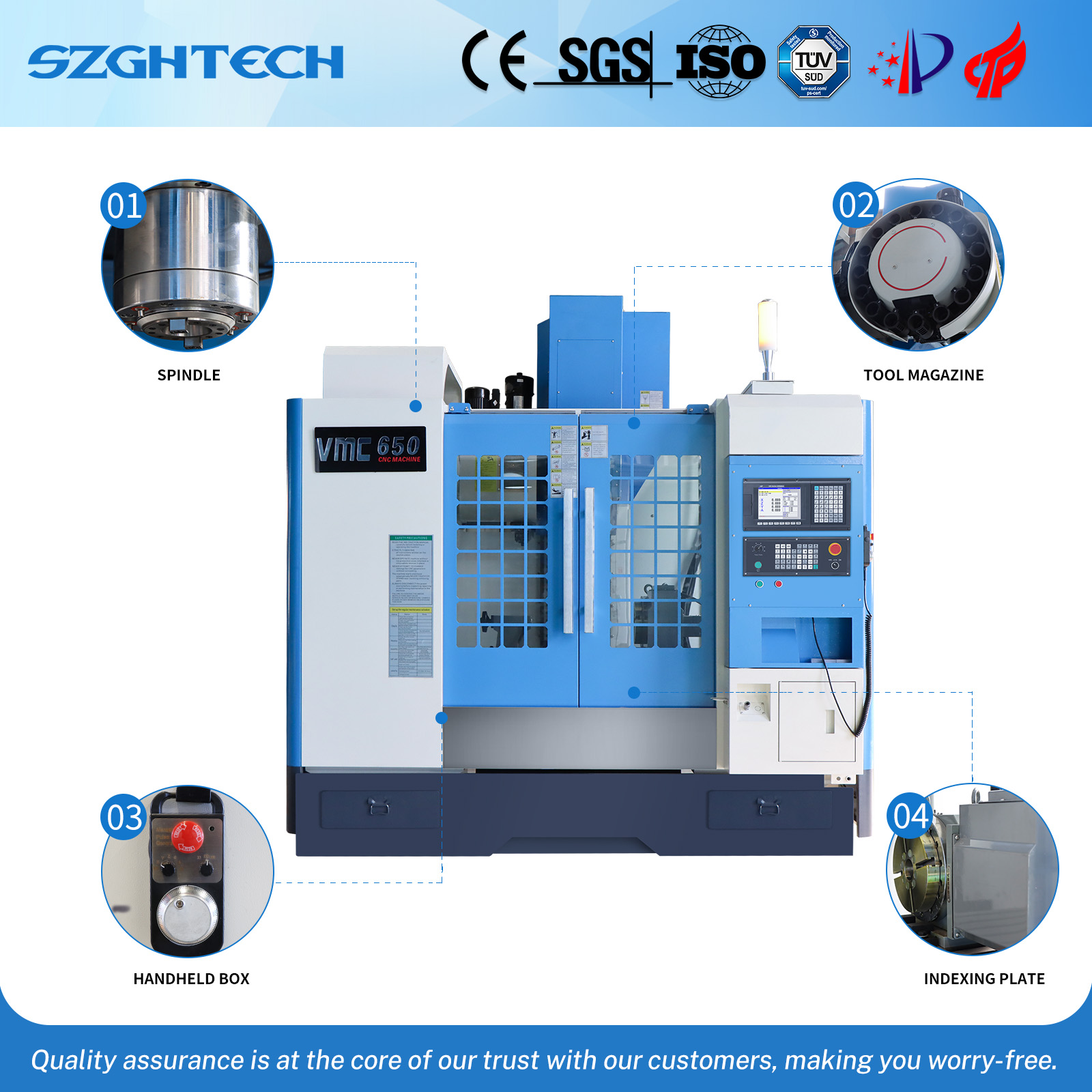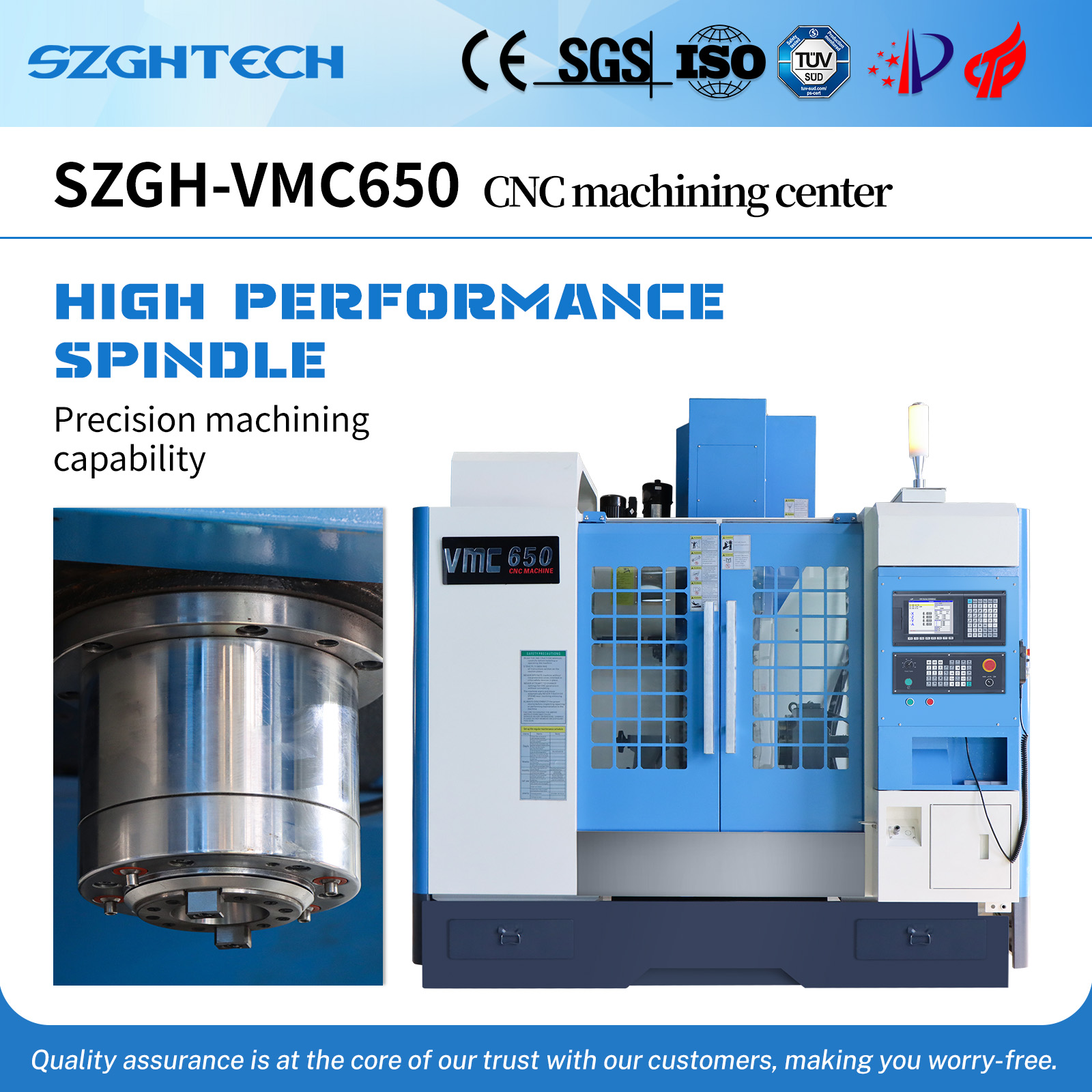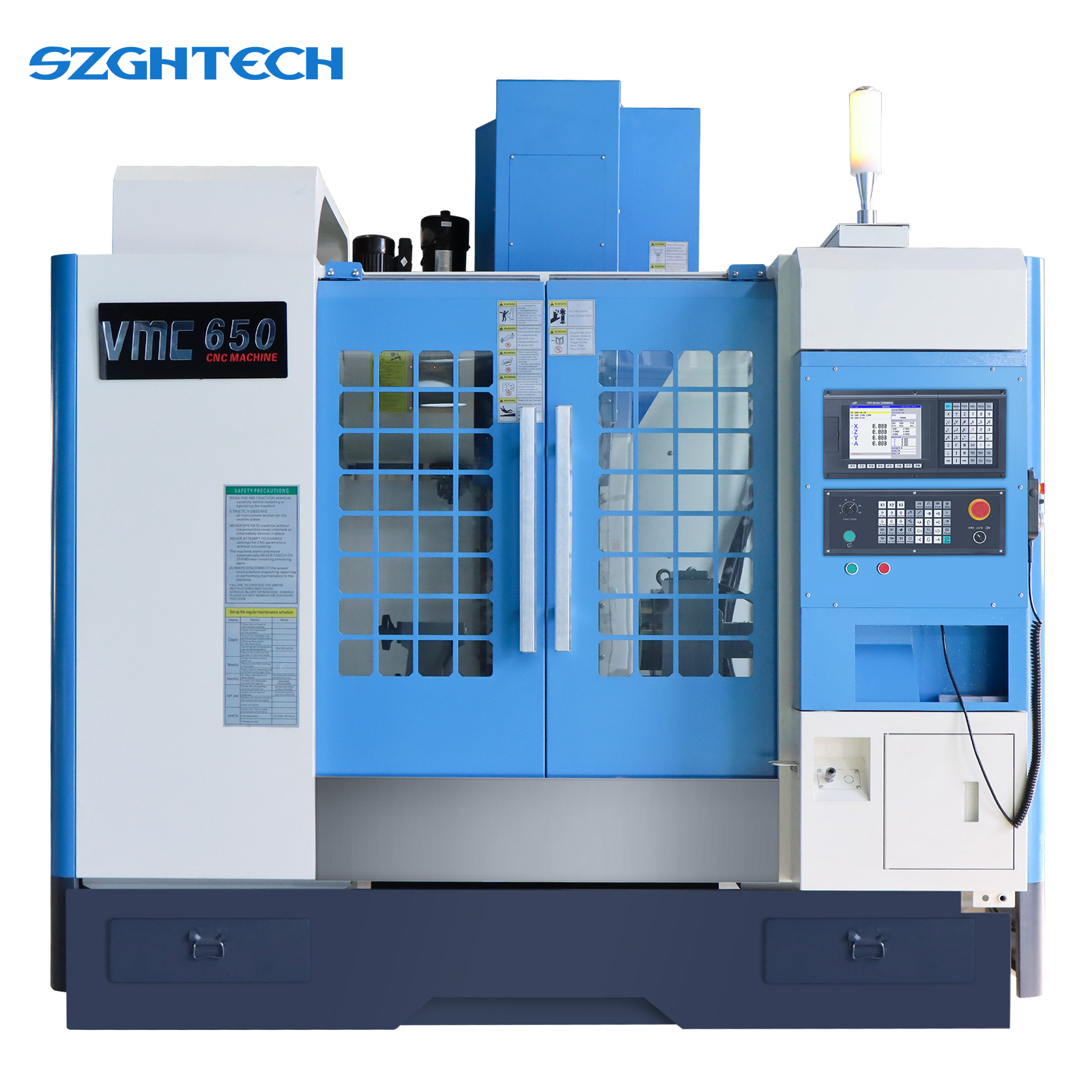1. VMC650 Milling Machine Core Positioning and Basic Parameters
The SZGH precision five-axis vertical CNC milling machine is a core device designed specifically for precision metal processing. It focuses on the integrated multi-step machining needs of small and medium-sized workpieces. With its high stability, high precision, and flexible adaptability, it is widely used in automotive parts, precision molds, aerospace components, medical devices, and other fields.

The basic specifications and core performance parameters of the VMC650 milling machine are as follows:
Processing travel: Adopting the standard VMC650 milling machine design, the X/Y/Z axis travel reaches 650 x 400 x 500 mm, respectively, covering the machining range of most small and medium-sized metal workpieces and adapting to diverse needs, from simple flat milling to complex curved surface machining.
Spindle system: Equipped with a 7.5 kW servo spindle motor and an SZGH10-2-35-5.5/7.5-4-1500 spindle servo unit, it delivers a stable output torque of 35 Nm, supports a maximum high-speed operation of 8000 rpm and a rated speed of 1500 rpm, balancing high-speed cutting efficiency with low-speed, heavy-load machining capabilities, easily handling the cutting needs of a variety of metal materials such as aluminum alloys, stainless steel, and titanium alloys.
Drive configuration: All three axes of X/Y/Z utilize SZGH130 servo motors, each with a drive power of 3.8 kW and an output torque of 15 Nm. Newton-meters, combined with a high-precision transmission structure, ensures smooth and responsive movement of each axis, reliably guaranteeing machining accuracy.
Tool Changing System: Equipped with an arm-type ATC-16 automatic tool changing system, it features fast tool changes and precise positioning, reducing waiting time during process switching, significantly improving batch processing efficiency, and meeting the needs of continuous multi-process production.
2. VMC Milling Machine Structural Design: Stability and Durability
To achieve long-term high-precision machining and low-failure operation, the machine's structural design has been optimized in multiple dimensions, focusing on stability, wear resistance, and vibration resistance from core components to the overall frame. Precision Connection and Lubrication Design: The VMC650 milling machine utilizes precision connections for key moving parts, coupled with a fully automatic lubrication system that intelligently replenishes lubricant based on the machine's operating status. This reduces friction between components, extends the service life of core components like the spindle and ball screw, and reduces the need for routine maintenance.

High-Precision Drive System: The X/Y/Z axes utilize high-quality ball screws with dedicated precision bearings. These ball screws offer minimal pitch error and high transmission efficiency, while the dedicated bearings provide excellent radial and axial stiffness. This combination effectively controls positioning errors (with micron-level accuracy), improves contour following performance, and avoids dimensional deviations caused by drive backlash during machining.
Strong Rigidity Frame Structure: The bed and columns, along with other major load-bearing components, are constructed from high-strength cast iron. A strategically designed internal rib layout reduces overall machine weight while significantly enhancing structural rigidity and vibration resistance—even at high spindle speeds (e.g., 8,000 rpm). This effectively suppresses vibration during high-speed machining (including high-speed cutting) or heavy-load cutting, preventing it from affecting surface finish and dimensional accuracy.
Low-noise, low-consumption spindle drive: The precision high-speed spindle unit and AC servo motor are driven by a synchronous belt. The belt's excellent elasticity and smooth transmission reduce vibration transmission during motor operation, lowering spindle operating noise (no-load noise ≤ 75 decibels). It also reduces spindle heat generation, preventing spindle deformation caused by elevated temperatures, and further ensuring stable machining accuracy.
3. Flexible Customization: The VMC650 milling machine can adapt to diverse machining needs.
To meet the personalized machining needs of customers in various industries, the machine offers a wealth of customization options, allowing for flexible adjustments from core components, performance parameters, to exterior features. These options include:
Core Component Options: Supports optional Taiwan-made spindles, ball screws, and precision bearings. Taiwanese components offer proven advantages in precision retention and durability, making them suitable for applications requiring the highest precision (such as precision mold cavity machining).
Guideway Upgrades: X/Y/Z-axis linear guides can be added. Compared to traditional sliding guides, linear guides offer lower friction, higher travel speeds, and better precision retention, further enhancing the machine's responsiveness and long-term machining stability.
Spindle Speed Boost: The default maximum speed is 8,000 rpm, which can be customized and upgraded to 10,000 rpm based on customer high-speed cutting requirements. The VMC650 milling machine is suitable for high-speed, low-force cutting of thin-walled parts and high-precision curved surfaces, minimizing workpiece deformation.
Operational Accessories: An optional portable handwheel allows operators to precisely control axis movement during manual adjustments and workpiece alignment, enhancing operational flexibility.
Appearance and Customization: The VMC650 milling machine supports OEM/ODM services, allowing customization of machine colors and logos based on customer branding requirements. It can also be adapted to different regional voltage standards (e.g., 110V, 220V, 380V, etc.) to meet the needs of diverse global markets.
4. Milling Controller: Intelligent and Precise Control Core
The machine is equipped with the SZGH three-axis CNC milling controller, serving as the "brain" of the entire system. It boasts powerful computing capabilities, extensive control functions, and a convenient user experience. Specific performance highlights are as follows:
Multi-axis Control and Full English Interface: Supports 2-5 axis linkage control, meeting the complex motion control requirements of five-axis machining centers. Equipped with an 8.4-inch 800×600 true-color LCD display and a full English user interface, the clear layout and intuitive icons facilitate rapid familiarity with operating procedures for customers worldwide, reducing language barriers.
Powerful Computing and Storage Capacity: Equipped with a 32-bit ARM microprocessor and FPGA technology, it offers fast computing speeds and robust data processing capabilities, enabling rapid analysis of complex machining programs and eliminating program lags. Built-in 64MB of system memory and 56MB of RAM User storage space allows for storing a large number of machining programs, meeting the demands of mass production and complex workpiece machining.
Efficient turret and tool changer control: Supports both electric and binary turret control, with a maximum tool capacity of 99. It seamlessly collaborates with the arm-mounted ATC-16 tool changer for automatic tool selection and switching. Comprehensive tool compensation (including length and radius compensation) allows real-time correction for tool wear or dimensional deviation after tool replacement, ensuring machining accuracy.
High-speed traverse and precise positioning: Supports rapid traverse speeds of up to 60 m/min and feed rates of 24 m/min. Rapid traverse reduces workpiece positioning time, and feed rates can be flexibly adjusted based on the material and process. Position control using pulse + direction/AB phase and 0-10V dual analog voltage outputs delivers high positioning accuracy and fast response, meeting the stringent position control requirements of precision machining.
Rich functionality and flexible expansion: Supports ATC automatic tool changer, macro programming, and PLC programmable logic control. Macro programming simplifies programming for complex workpieces, and PLC This function allows customers to customize the device's I/O logic based on production requirements. Equipped with a highly anti-interference switching power supply (input 100V-240VAC 50Hz/60Hz, output 24VDC), it adapts to regional grid voltage fluctuations and ensures stable operation of the control center. A USB interface supports USB flash drive file transfer (such as program import and export), system configuration backup, and software upgrades, ensuring convenient and efficient operation.
Precision spindle control supports continuous servo spindle positioning, rigid tapping, and rigid threading. Rigid tapping precisely synchronizes spindle speed and feed rate, avoiding tap wear and thread accuracy deviation associated with traditional flexible tapping. It is particularly suitable for high-precision threaded hole machining. VMC 650 Milling Machine Typical Applications and Core Advantages
Automotive Parts Processing: For precision components such as engine blocks and transmission gears, the machine uses five-axis linkage to mill complex curved surfaces and process high-precision holes. Rigid tapping allows for threading, allowing multiple machining steps to be completed in a single clamping setup, reducing clamping errors and improving part consistency.
Precision Mold Manufacturing: In the machining of plastic molds and stamping dies, the machine's micron-level positioning accuracy and low vibration ensure surface finish (Ra values below 0.8μm) and dimensional accuracy within the mold cavity. The optional high-speed spindle and linear guides enhance machining efficiency and surface quality on curved mold surfaces.
Aerospace Parts Processing: For difficult-to-machine materials such as titanium alloys and high-temperature alloys commonly used in the aerospace industry, the machine's 7.5 The kW spindle motor's high torque output and stable cutting performance enable efficient cutting. The five-axis linkage function also accommodates the machining needs of complex, custom-shaped components such as blades and stents.
Medical device processing: Medical devices require extremely high precision and surface quality. The machine's high-precision transmission and tool compensation ensure accurate machining of surgical instruments and implantable components. The all-English control interface and flexible voltage customization also facilitate export to global markets. VMC650 Milling Machine Quality Assurance and After-Sales Service
Quality Standards: Core components (such as the spindle, servo motor, and ball screw) undergo rigorous quality inspection. The entire machine undergoes 72 hours of continuous operation testing and precision calibration before shipment to ensure compliance with China's top quality standards.
After-Sales Service: We offer 24/7 response time. In the event of a machine malfunction, our technical team provides remote guidance to quickly troubleshoot the problem. If on-site repair is required, we dispatch a service representative based on the customer's location. We also maintain a sufficient spare parts inventory for core components (such as the spindle unit, milling controller module, and ball screw) to ensure rapid spare part availability and minimize equipment downtime.
Technical Support: We provide free machine operation training and programming guidance, including hands-on milling machine operation, milling controller function debugging, and routine maintenance. This helps customers quickly master machine operation techniques and maximize their performance.






